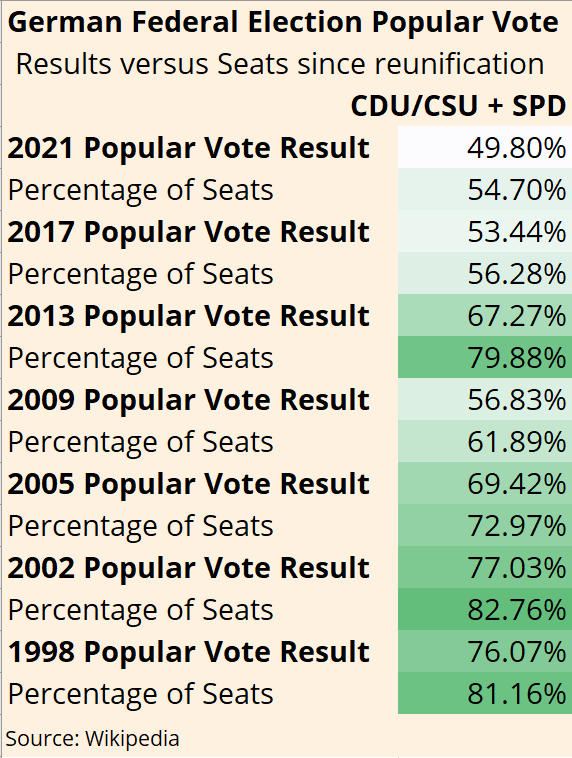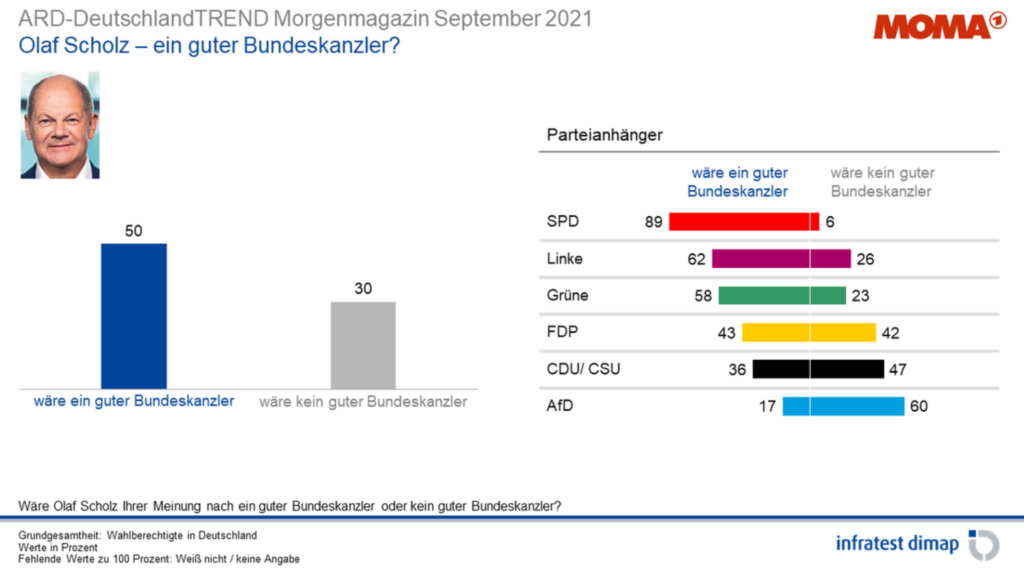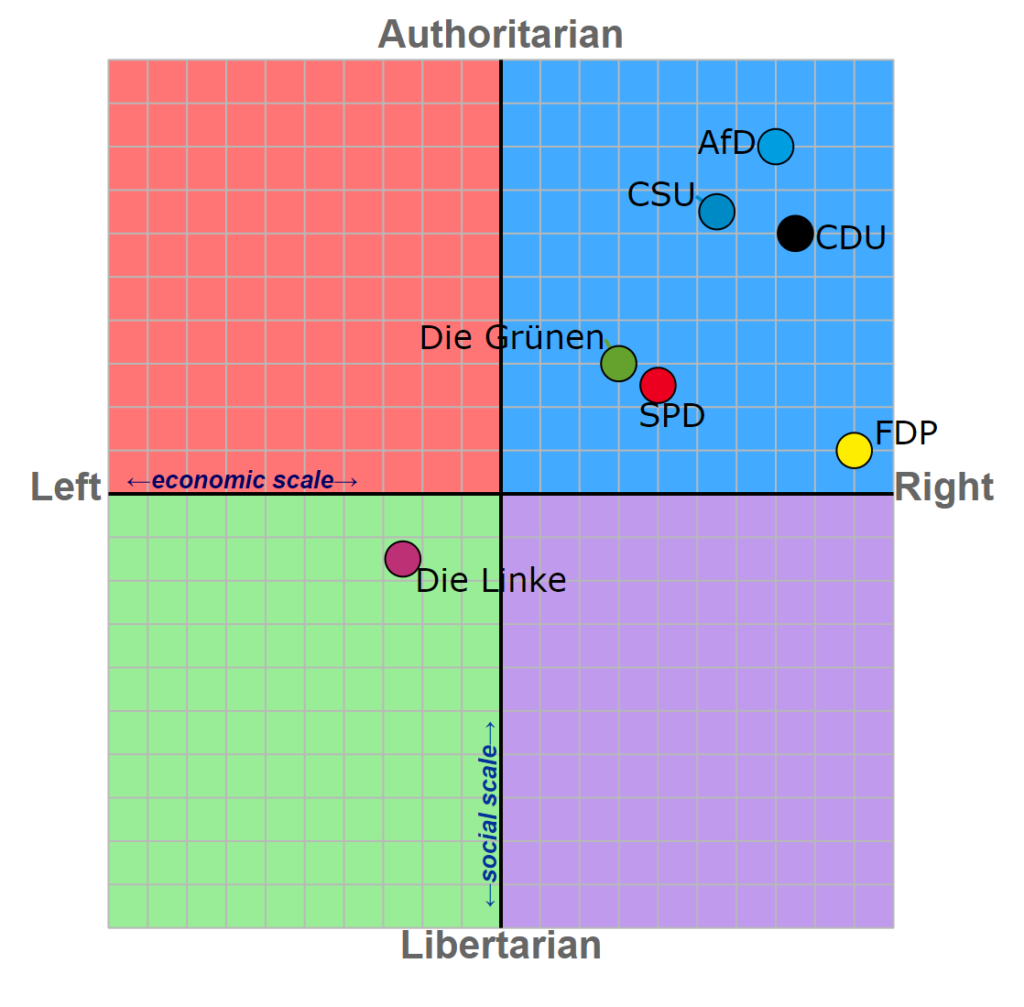
Wednesday Oct 6 2021 09:14

8 min
After a wild ride in the polls where the CDU, Greens and SPD each took the lead one after the other in the months leading up to the election, the Germans eventually voted for None of the Above. Every party was left disappointed:
• The CDU posted their worst ever result at 24.1%
• The SPD came too close to the CDU/CSU for comfort, just ahead at 25.7%
• The Greens had hoped to clear 20% but managed barely 15% of the vote
• The FDP had hoped to come third but added less than 1 pct pt to their last result
• The Left barely scraped the 5% threshold
The two traditional large parties, the CDU and SPD, together failed to reach even 50% of the vote, demonstrating the frustration of German voters as they look for a new home.

This decline in the two main parties means that for the first time in post-war Germany a majority coalition will require three parties. But which three will it be?
Beep beep! We can’t help but think of frustrated drivers when we hear Germany might end up with a traffic light coalition. So-called because it would include the parties who are denoted by the colours Red (SPD), Yellow (FDP), and Green. But in a dramatic lurch off the autobahn, just switching out one large party for the other and bringing in the CDU/CSU (Black) would apparently leave us sitting in the Caribbean sunshine, with those colours representing Jamaica’s national flag.
Forget this dizzying array of colour combinations. You only need to look at the election results to know that the government will be going left and going green.
The two parties with the most momentum and therefore the most mandate to govern are the SPD and the Greens. The latter saw their vote share jump by two thirds since the last election, they’ve regularly polled in at least second place in the last three years, and they’ve firmly put environmental issues on the map. All the Chancellor candidates of the three biggest parties responded firmly that climate change is man-made when asked by Die Zeit magazine.
For the SPD, their man Olaf Scholz commands the most public support to become leader of Germany. Even one-third of CDU/CSU voters have to admit he would be a good Chancellor, according to a post-election poll from Infratest Dimap:

That same poll shows that 60% of CDU/CSU voters think their candidate, Armin Laschet, has performed so poorly that he should resign.
Forming a coalition isn’t just about racking up the numbers: it must have public support as well. Just remember Pedro Sanchez in Spain who became Prime Minister in June 2018 despite his party holding only 84 seats. He was able to govern for almost a year before he had to go to the polls.
The CDU simply cannot claim enough support to be a senior party in government after results like these.
So why is the FDP still pursuing the CDU? This all comes down to their leader, Christian Lindner, who managed to resurrect the party after their disastrous election result in 2013 where they failed even to overcome the 5% threshold for parliamentary representation. He has certainly effected an impressive turnaround, enough that he almost formed part of the coalition after the 2017 election.
But he walked out of those negotiations, using words that will soon come to haunt him: “it’s better not to govern than to govern wrongly”. In doing so he forced the CDU back into a grand coalition with the SPD and subjected Germany to almost six months without a government. It became the straw that broke the camel’s back for Merkel, as she announced her retirement just seven months after that. This leaves Lindner a dangerous and unreliable coalition partner. If the SPD and Greens were to include the FDP they run the risk of always being subject to a potential walk-out, giving Lindner uncomfortable outsized veto power. The Green Party co-leader Habeck has already cautioned that a “traffic light” coalition is not just ‘red and green with a bit of yellow speckled on it’.
It might be bearable if Lindner were on the same policy page as the other traffic lights. But ideologically, he’s too far away from the SPD and the Greens, not least because he wants to reimpose the debt brake whilst the others understand that doing so would kill the economy. The co-leader of the SPD warned the morning after the election that ‘the FDP wants dramatic tax cuts, they don’t want to take out loans but they also want to invest. That’s voodoo economics, it doesn’t work’.
The Political Compass test (you can take it yourself here) places parties on the left-right economic axis, along with their position as authoritarian versus libertarian. You can see from their analysis of the German parties just how far out there the FDP sit:

But the FDP think they hold all the cards, and will try to play off the CDU against the SPD. In overplaying his hand, Lindner will fail to compromise and so will not form part of the government.
For the SPD, doing a deal with the FDP is not a price worth paying. Scholz would prefer a weakened CDU to an awkward Lindner. And so, after all the sound and fury of backroom deals and coalition quibbles, the SPD and Greens will be left with two choices: Either become Germany’s first post-war minority government; or bring back into the tent a humiliated CDU/CSU who will obey their radical policy platform.
The latter would be more likely to last the parliamentary term, not least given it represents the votes of almost 70% of the population. But to sell it to the public, we must first go through the rigmarole of entertaining the FDP as a potential option. It’s only by airing how intransigent they are to the public that the electorate will understand why the FDP can’t be part of the government.
This is also required to sell the eventual coalition to the parties themselves. Both the CDU and SPD are struggling with internal party strife. Scholz in particular needs to put his stamp on the SPD having lost out on becoming their leader just two years ago. Laschet might find he loses out entirely and is reshuffled away in order for the CDU to retain some scrap of power.
The colours have been nailed to the mast: Germany is going left and going green.
